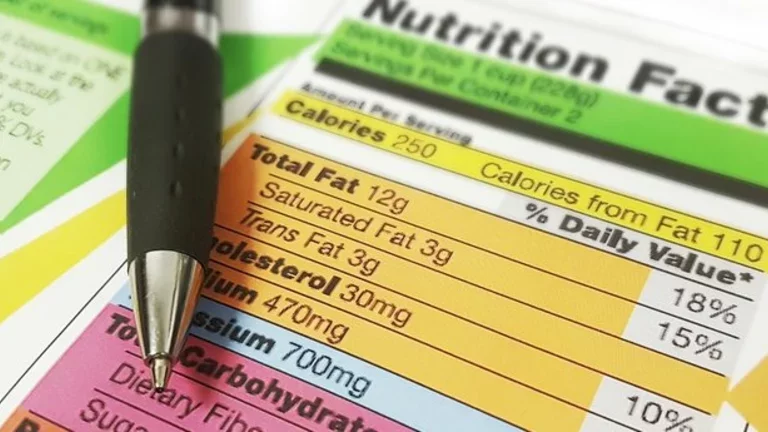The Nutrition Label may look encrypted and confusing, but it is a source of healthy eating facts that informs us about the foods we purchase, and helps us make healthy food choices.
Helpful tips for reading and using the nutrition label:
-
Step 1: Look at the serving size
Compare the serving sizes on products you wish to buy with the amount that you normally eat. If you eat the serving size shown on the nutrition label, you will consume the listed amount of calories and nutrients. If you eat a different serving size the nutritional values you consume will be different as well.
-
Step 2: Check the calories
The calories tell you how much energy you get from one serving size of the packaged food.
-
Step 3: Read the percent Daily Value (% Daily Value)
% Daily Value tells you how much there is of a nutrient in a packaged food. On a scale of 0% to 100%, you can find out if there is a little (5% or less) or a lot (15% or more) of a nutrient in one serving of a packaged food. Use this percentage to compare the nutrient content of different foods.
-
Step 4: Look for the good carbohydrates
Carbohydrates can be divided into 3 general groups: sugars, starch and fibre. Studies support that carbohydrates from fibres are important for people with prediabetes and diabetes, and that foods such as whole grains, fruits and colourful vegetables should be included in their diet.1
|
Soluble fibre |
Insoluble fibre |
|---|---|
|
May be especially helpful for people with diabetes. It is found in oats, barley, legumes (dried beans and lentils), and some vegetables and fruits such as eggplant, okra, apples and berries. It can help improve blood sugar management by slowing down digestion, leading to more stable blood sugar levels after eating. It also has a cholesterol-lowering effect and may help reduce the risk of heart disease.2 |
Helps to prevent constipation and is present in wheat bran, whole grain breads and cereals, fruits and vegetables. Many foods contain both soluble and insoluble fibre.3 |
-
Step 5: Look for the good fats
Unsaturated fats such as polyunsaturated fatty acids and monounsaturated fats, have been shown to have a positive impact on reducing cholesterol. They come from foods such as avocados, fatty fish like salmon, trout, mackerel, sardines and herring, nuts, chia seeds and cheese.
-
Step 6: Eat less of these nutrients
Sugars, saturated and trans fats, sodium and cholesterol are not great for your health. These can be found in abundance in processed foods.4
Here's an example:
| Frosted Flakes | 1- Minute Oats |
|---|---|
|
|
|
What are the Serving sizes? The label on the left refers to 1 box (34g) of frosted flakes breakfast cereal and the label on the right refers to ½ cup (40g) of 1-minute oats. While the serving sizes differ they are both common breakfast serving sizes, so we can compare them side by side.
How many calories? - 34g of cereal contain 130 calories. 40g of oats contain 150 calories. Their calories per gram amounts are similar.
% Daily Value - Scan the numbers and compare which food is higher or lower in particular nutrients.
The carbohydrates - Of the 34g per serving of frosted flakes cereal, 30g are carbohydrates. Of which, 12g are sugars and less than 1g is fibre. Conversely, of the 40g per serving of Oats, 27g are carbohydrates. Of which, 4g are deemed to be good dietary fibres (2g soluble and 2g insoluble) and only 1g are sugars. Therefore the oats are the healthier choice for people who are watching their sugar intake.
Why does the total amount carbohydrates not match the listed sugars and fibres?
The total amount of carbs, including dietary fibre and sugars must be shown by law, but manufacturers can choose whether or not to include other carbohydrate subcategories such as sugar alcohol, soluble and insoluble fibre, starches, and more.
Are there healthy fats? The cereals have 0g of fats. The oats have 3g, 2g of which are healthy unsaturated fats with numerous health benefits.
The nutrients you want less of - The saturated and trans fat measures on both labels are very close. However, the frosted cereal has 160mg of sodium and 12g of sugars. The oats have 0 mg of sodium and only 1g of sugar.
To conclude, the nutrition facts help you:
- Compare foods more easily.
- Find out the nutritional value of foods
- Manage special diets better, such as one that counts carbs
- Consciously increase or decrease your intake of a particular nutrient (for example, increase fibre, decrease saturated fat)
References:
- http://www.unlockfood.ca/fr/Articles/Etiquetage-des-aliments/Comment-dec... .
- http://care.diabetesjournals.org/content/27/suppl_1/s36 .
- https://www.diabetes.ca/diabetes-and-you/healthy-living-resources/diet-n... .
- https://www.diabetes.ca/diabetes-and-you/healthy-living-resources/diet-n... .
- https://www.ncbi.nlm.nih.gov/books/NBK279012/ .





